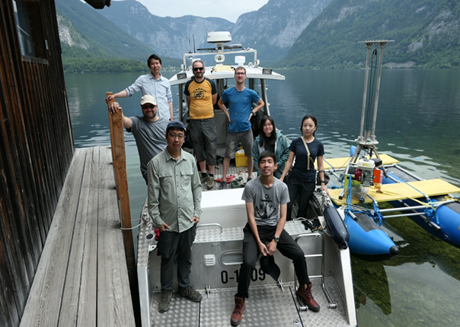The EAGER-TRAINING Project – a Cooperative Research Project between Taiwan and Austria on Extreme Events and Related Consequences on Human-Environmental Interaction Archived in the Geological Record

A team from the Institute of Oceanography at National Taiwan University was invited to the Sedimentary Geology Group of the University of Innsbruck, Austria, to participate in the XRF-Core scanning of samples from the International Ocean Discovery Program (IODP) Expedition 386 - Japan Trench Paleoseismology and they spent from May to July there. Researchers hope to use the detailed geochemical profiles obtained using the X-ray fluorescence core scanner at the Austrian Core Facility at the university to relevel the spatial and temporal distribution of traces of earthquakes to finally develop a long-term record of earthquakes in the Japan Trench.
The Taiwanese and Austrian researchers are collaborating in a project called EAGER-TRAINING: The Austria–Taiwan Joint Project on Extreme Events and Related Consequences on Human-Environmental Interaction Archived in the Geological Record. The project is equally funded by the Federal Ministry of Education, Science and Research (BMBWF) in Austria and the Ministry of Education in Taiwan, on the basis of a memorandum of understanding signed in 2019, and administered by the OeAD—Austria’s Agency for Education and Internationalization.
The aim of the EAGER-TRAINING project is to develop a collaborative training network between Austria and Taiwan to advance our understanding of the hazard-related interaction between humans and their environment by studying sedimentary archives. The project was jointly initiated by Prof. Michael Strasser, head of the Sedimentary Geology Working Group at the University of Innsbruck, Dr. Steven Jyh-Jaan Huang, postdoctoral researcher at the University of Innsbruck, and Dr. Sofia Ya-Hsuan Liou from National University of Taiwan (NTU).
The project took the Taiwanese team and their Austrian colleagues to Lake Hallstatt from June 21 to 24 to collect samples of lake sediments. The team members were: Prof. Michael Strasser, Yin Lu, Gerald Degenhart, and Marcel-Luciano Ortler from the Sedimentary Geology Working Group at the University of Innsbruck, Dr. Steven Jyh-Jaan Huang from the University of Innsbruck, and Shao Yu-Hsun, Lin Jun-Ting, and Cheng Ya-Fang from the the Institute of Oceanography at NTU.
This is an alpine lake located in a UNESCO World Heritage site region of upper Austria that has been recognized as an ideal site to study the causes and consequences of natural perturbations and resiliencies of the interlinked socio-environmental system by collecting lake sediment samples.
Prof. Strasser and his team work on these precious natural records to decipher signs of floods, debris flows, gravitational mass-movement events, earthquakes, and even salt mining activities. The Taiwanese team members are providing details of their experiences of earthquake and flood sedimentations and their expertise in biogeochemical perspectives to help clarify the diverse laminations—sediment layers with various colors—in the samples taken from the lake, to advance the research in Lake Hallstatt.
The on-lake field work gave the Taiwanese team a valuable opportunity to experience the entire on-lake sampling process, from setting up the sampling equipment to getting the cores. The field trip was very successful: everyone obtained critically valuable samples and there were intense science discussions and active interactions between Taiwanese and Austrian participants. The Taiwanese team also visited the ancient Hallstatt Salt Mine, a world-famous archaeological site and Dr. Hans Reschreiter from the Natural History Museum of Vienna outlined the complete history of human habitation in the Hallstatt area.
After the field trip, initial core analyses and subsampling were performed in the Austrian Core Facility. Samples will be sent back to Taiwan for further analysis, including their pore water geochemistry, environmental DNA, radionuclides, and organic proxies. The Austria-Taiwan team is looking forward to the new results and further discussion. They believe that their recent work together can lead to more beneficial cooperation in the near future.
The Taiwanese team also attended the joint XRF data process workshop and weekly scientific discussions with colleagues in the Sedimentary Geology Working Group. Taiwan is tectonically very active and is frequently visited by typhoon, so the geo-hazards and sedimentary environments are very different from the those in Alps in their magnitude and their mechanisms. The Taiwanese researchers took this opportunity to discuss potential cooperation and outlined potential road maps with their Austrian colleagues.
The EAGER-TRAINING project and related efforts are enhancing the current research cooperation between Taiwan and Austria. They are also providing an excellent platform for the participating students to work together and interact with early-career scientists from Taiwan and Austria.